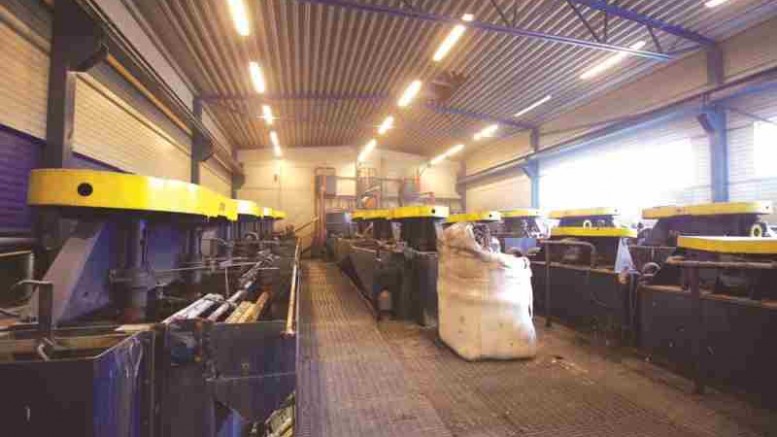Just outside the small town of Edsbyn central Sweden sits the idle Kringel graphite mine, which represents a prime opportunity according to Vancouver-based Flinders Resources (FDR-V).
With the deposit delineated by the Swedish government in the 1980s, the Kringel project was developed for US$13 million in 1995. The mine produced flake graphite through 2001 before it was put on care and maintenance owing to a supply push from China that depressed global graphite prices.
Comprising four separate mineral licences within 25 km of a fully built processing facility, Kringel produced as much as 13,000 tonnes of graphite annually with average purities ranging from 85% to 94% graphitic carbon.
“The Kringel graphite mine is one of the most advanced graphite projects globally, and being already fully permitted and constructed, will be amongst the first to deliver premium high-quality, large-flake graphite to European customers,” president and CEO Martin McFarlane comments. “There exists a great opportunity to scale up future production from the mine site area, and meet growing demand for high-purity flake graphite.”
Historic mining activities focused on the Kringelgruvan quarry, with overburden having been removed from the Central and South zones in addition to ramp construction along the deposit’s Western zone, which was developed as mining moved to greater depths. The Kringelgruvan pit holds a historic resource totalling 1.3 million measured and indicated tonnes grading 11.4% carbon.
The northernmost Gropabo deposit hosts graphite mineralization over 480 metres of strike that covers two discrete zones, with the western zone boasting higher grades than its eastern counterpart. Gropabo holds historic indicated resources totalling 2.1 million tonnes grading 6.9% carbon. Previous exploration campaigns have only extended to depths of 50 metres, with mineralization open at depth and along strike to the southeast.
Mattsmyra is another deposit located northwest of the historic Kringelgruvan pit, holding a historic resource of 2.2 million indicated tonnes grading 8.8% carbon. Folding and faulting have cut the mineralized zone into several bodies, with the explored zone extending 2.5 km along strike, and remaining open at depth.
Mansberg is the southernmost deposit, and has been drilled along twin conductive zones that are 200 metres apart and open to the southeast. Mansberg holds 1.4 million inferred tonnes carrying 9.4% carbon, and will likely be heavily targeted by exploration drilling in a bid to expand the resource.
According to Flinders, the total historic (i.e. non-National Instrument 43-101-compliant) resource of 6.9 million tonnes at 8.8% carbon could support a mine for over 30 years. The deposits also host a variety of flake calibres, and the company has conducted preliminary metallurgical testing indicating it could reach high-end purities of 99.5% carbon through a two-stage chemical process. Production to date has focused on a traditional flotation circuit, which limits purities to a maximum of 94%.
Though Flinders has an interesting combination of grade and flake size, it could be the company’s access to infrastructure that gives it the upper hand in what has become a global race to production in the graphite space. Kringel’s processing facilities include a beneficiation plant with a throughput capacity of 140,000 tonnes per year, a rod-and-ball mill and a flotation and gravimetric separation system.
Kringel comes with a full 13,000-tonne-per-year production permit and, located 300 km north of Stockholm, is strategically located to meet European and Asian graphite demand. The site is 15 km from a railway shipping line, 75 km by road to Sweden’s Soderhamn harbour and 150 km away from the Gavle container port. Being Europe’s largest iron-ore producer, Sweden is also an established mining jurisdiction, with strong labour availability and a settled permitting system.
Flinder is reprocessing and selling 75,000 tonnes of stockpiled graphite on spot markets, and has undertaken a resource drill program aimed at confirming the project’s historic resources. The Kringelgruvan plant will also require refurbishing, while tailings facilities will need to be upgraded to meet environmental standards.
Through mid-July Flinders has released results from 15 holes of its 37-hole program, and announced 700 more metres of drilling, with an updated resource expected by the end of August.
The company is hitting strong grades within 100 metres of surface. Highlights include 14 metres carrying 11.8% carbon starting from 89 metres depth in hole 3; 8 metres grading 18.3% carbon from 68 metres in hole 7; 10 metres of 10.8% carbon from 26 metres in hole 14; and 19 metres grading 8% carbon from 17 metres in hole 13.
“Our drilling has met or exceeded all expectations. We have verified that graphite mineralization shows continuity of width and grade along strike and downdip, and is consistent with historical data,” McFarlane says. “Drilling has extended known mineralization to 100 metres depth, and new graphite zones have been identified parallel and downdip from known mineralization.”
Flinders has had no trouble raising money so far for its project. It joined the TSX Venture Exchange in mid-February, and has completed a $5.2-million private placement consisting of 10.4 million units. The company followed up with another placement in early March, when it raised $15 million by placing 8.8 million shares at $1.70 per unit.
“Importantly, with Kringel at such an advanced stage of development, the cost of restarting operations will be relatively modest, and this financing is expected to deliver most — if not all — of its restart budget requirements,” McFarlane predicts.
Flinders has received a market boost since the end of June, with company shares leaping 24%, or 32¢ since the first week of July, en route to a $1.68 presstime close. Recent drill results are providing momentum, as Flinders enjoyed a 5%, or 8¢ jump, following its most recent drilling update on July 9. The company maintains 45 million shares outstanding — 18% being held by insiders — and a $76-million market capitalization.


Be the first to comment on "Flinders sees upside in Swedish graphite revival"